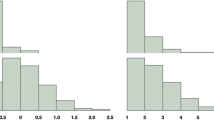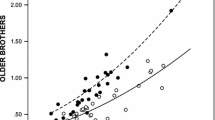Abstract
Available evidence suggests that male homosexuality is both familial and somewhat heritable and that some cases may be caused by an X-linked gene. However, most studies have recruited subjects in a relatively unsystematic manner, typically via advertisements, and hence suffer from the potential methodological flaw of ascertainment bias due to volunteer self-selection. In the present study we assessed the familiality of male homosexuality using two carefully ascertained samples and attempted to replicate findings consistent with X-linkage in three samples. The percentage of siblings of the probands rated as either homosexual or bisexual, with a high degree of certainty, ranged from 7 to 10% for brothers and 3 to 4% for sisters. These estimates are higher than recent comparable population-based estimates of homosexuality, supporting the importance of familial factors for male homosexuality. Estimates of λs for male homosexuality ranged from 3.0 to 4.0. None of the samples showed a significantly greater proportion of maternal than paternal homosexual uncles or homosexual male maternal first cousins. Although our results differed significantly with those of some prior studies, they do not exclude the possibility of moderate X-linkage for male sexual orientation.
Similar content being viewed by others
REFERENCES
Bailey, J. M. (1995). Sexual orientation revolution [news]. Nature Genet. 11: 353–354.
Bailey, J. M., and Bell, A. P. (1993). Familiality of female and male homosexuality. Behav. Genet. 23:313–322.
Bailey, J. M., and Benishay, D. S. (1993). Familial aggregation of female sexual orientation. Am. J. Psychiatry 150:272–277.
Bailey, J. M., and Pillard, R. C. (1991). A genetic study of male sexual orientation. Arch. Gen. Psychiatry 48:1089–1096.
Bailey, J. M., and Pillard, R. C. (1995). Genetics of human sexual orientation. Annu. Rev. Sex Res. 6:126–150.
Bailey, J. M., Willerman, L., and Parks, C. (1991). A test of the maternal stress theory of human male homosexuality. Arch. Sex. Behav. 20:277–293.
Bailey, J. M., Pillard, R. C., Neale, M. C., and Agyei, Y. (1993). Heritable factors influence sexual orientation in women. Arch. Gen. Psychiatry 50:217–223.
Bailey, J. M., Dunne, M. P., and Martin, N. G. (1999). The distribution, correlates, and determinants of sexual orientation in an Australian twin sample (submitted for publication).
Bell, A., and Weinberg, M. (1978). Homosexualities: A Study of Diversity Among Men and Women, Simon and Schuster, New York.
Blanchard, R. (1997). Birth order and sibling sex ratio in homosexual versus heterosexual males and females. Annu. Rev. Sex Res. 8:27–67.
Buhrich, N., Bailey, J. M., and Martin, N. G. (1991). Sexual orientation, sexual identity, and sex-dimorphic behaviors in male twins. Behav. Genet. 21:75–96.
Eckert, E. D., Bouchard, T. J., Bohlen, J., and Heston, L. L. (1986). Homosexuality in monozygotic twins reared apart. Br. J. Psychiatry 148:421–425.
Ellis, L., and Ames, M. A. (1987). Neurohormonal functioning and sexual orientation: A theory of homosexuality-heterosexuality. Psychol. Bull. 10:233–258.
Friedman, R. C., and Downey, J. (1993). Neurobiology and sexual orientation: Current relationships. J. Neuropsychiatry Clin. Neurosci. 5:131–153.
Hamer, D., and Copeland, P. (1994). The Science of Desire: The Search for the Gay Gene and the Biology of Behavior, Simon & Schuster, New York.
Hamer, D. H., Hu, S., Magnuson, V. L., Hu, N., et al. (1993). A linkage between DNA markers on the X chromosome and male sexual orientation. Science 261:321–327.
Hu, S., Pattatucci, A. M. L., Patterson, C., Li, L., Fulker, D. W., Cherny, S. S., Kruglyak, L., and Hamer, D. H. (1995). Linkage between sexual orientation and chromosome Xq28 in males but not in females. Nature Genet. 11:248–256.
Jaffe, H. W., Choi, K., Thomas, P. A., Haverkos, H. W., Auerbach, D. M., Guinan, M. E., Rogers, M. F., Spira, T. J., Darrow, W. W., Kramer, M. A., et al. (1983). National case-control study of Kaposi's sarcoma and Pneumocystis carinii pneumonia in homosexual men. Part 1. Epidemiological results. Ann. Intern. Med. 99:145–151.
Kendler, K. S., and Eaves, L. J. (1989). The estimation of probandwise concordance in twins: The effect of unequal ascertainment. Acta Genet. Med. Gemellol. Twin Res. 38:253–270.
King, M., and McDonald, E. (1992). Homosexuals who are twins. A study of 46 probands. Br. J. Psychiatry 160:407–409.
Kinsey, A. C., Pomeroy, W. B., and Martin, C. E. (1948). Sexual Behavior in the Human Male, W. B. Saunders, Philadelphia and London.
Laumann, E. O., Gagnon, J. H., Michael, R. T., and Michaels, S. (1994). The Social Organization of Sexuality: Sexual Practices in the United States, University of Chicago Press, Chicago, pp. 283–320.
LeVay, S. (1996). Queer Science: The Use and Abuse of Research into Homosexuality, MIT Press, Cambridge, MA.
Pattatucci, A. M. L., and Hamer, D. H. (1995). Development and familiality of sexual orientation in females. Behav. Genet. 25:407–420.
Pillard, R. C. (1990). The Kinsey scale: Is it familial? In McWhirter, S. A. S. J. M. R. D. P. (ed.), Homosexuality/Heterosexuality: Concepts of Sexual Orientation. The Kinsey Institute Series, Vol. 2, Oxford University Press, New York, pp. xxvii, 423.
Pillard, R. C., and Weinrich, J. D. (1986). Evidence of familial nature of male homosexuality. Arch. Gen. Psychiatry 43:808–812.
Rice, G., Anderson, C., and Ebers, G. (1995). Male homosexuality: Absence of linkage to microsatellite markers at Xq28. Paper presented at the Twenty-First Annual Meeting of the International Academy of Sex Research, Provincetown, MA, Sept. 20–24.
Risch, N. (1990). Linkage strategies for genetically complex traits. I. Multilocus models. Am. J. Hum. Genet. 46:222–228.
Risch, N., Squires-Wheeler, E., and Keats, B. J. B. (1993). Male sexual orientation and genetic evidence. Science 262:2063–2065.
Spira, A., et al. (1993). Les Comportements Sexuels en France, La documentation Francaise, Paris.
Spira, A., Bajos, N., Bejin, A., Beltzer, N., et al. (1992). AIDS and sexual behaviour in France. Nature 360:407–409.
Turner, W. J. (1995). Homosexuality, type 1: an Xq28 phenomenon. Arch. Sex. Behav. 24:109–134.
Wellings, K., Field, J., Johnson, A., and Wadsworth, J. (1994). Sexual Behavior in Britain: The National Survey of Sexual Attitudes and Lifestyles, Penguin, New York.
Whitam, F. L., Diamond, M., and Martin, J. (1993). Homosexual orientation in twins: a report on 61 pairs and three triplet sets. Arch. Sex. Behav. 22:187–206.
Author information
Authors and Affiliations
Rights and permissions
About this article
Cite this article
Bailey, J.M., Pillard, R.C., Dawood, K. et al. A Family History Study of Male Sexual Orientation Using Three Independent Samples. Behav Genet 29, 79–86 (1999). https://doi.org/10.1023/A:1021652204405
Issue Date:
DOI: https://doi.org/10.1023/A:1021652204405




